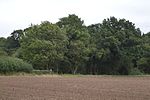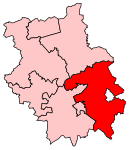West Wratting
Civil parishes in CambridgeshireSouth Cambridgeshire DistrictVillages in Cambridgeshire

West Wratting is a village and civil parish 10 miles southeast of Cambridge in Cambridgeshire. At 390 feet (120 m) above sea level, it can claim to be one of the highest villages in Cambridgeshire. The parish covers 3,543 acres in south east Cambridge, a thin strip, less than two miles wide, stretching from the London to Newmarket road to the border with Suffolk. Much of its western border follows the Fleam Dyke. It is bordered by Weston Colville to the north and east, and by Balsham and West Wickham to the south.
Excerpt from the Wikipedia article West Wratting (License: CC BY-SA 3.0, Authors, Images).West Wratting
The Causeway, Cambridgeshire
Geographical coordinates (GPS) Address Nearby Places Show on map
Geographical coordinates (GPS)
| Latitude | Longitude |
|---|---|
| N 52.146 ° | E 0.346 ° |
Address
St Andrew's
The Causeway
CB21 5NA Cambridgeshire (South Cambridgeshire)
England, United Kingdom
Open on Google Maps









